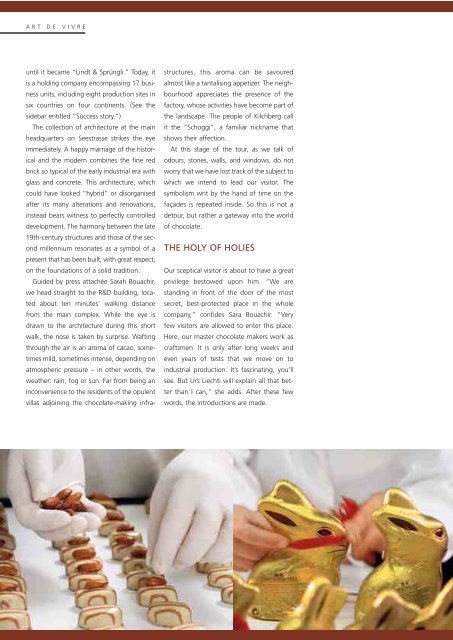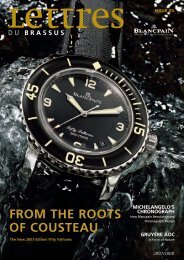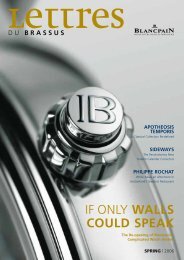THE HISTORY OF BLANCPAIN
THE HISTORY OF BLANCPAIN
THE HISTORY OF BLANCPAIN
You also want an ePaper? Increase the reach of your titles
YUMPU automatically turns print PDFs into web optimized ePapers that Google loves.
ART DE VIVRE<br />
until it became “Lindt & Sprüngli.” Today, it<br />
is a holding company encompassing 17 business<br />
units, including eight production sites in<br />
six countries on four continents. (See the<br />
sidebar entitled “Success story.”)<br />
The collection of architecture at the main<br />
headquarters on Seestrasse strikes the eye<br />
immediately. A happy marriage of the historical<br />
and the modern combines the fine red<br />
brick so typical of the early industrial era with<br />
glass and concrete. This architecture, which<br />
could have looked “hybrid” or disorganised<br />
after its many alterations and renovations,<br />
instead bears witness to perfectly controlled<br />
development. The harmony between the late<br />
19th-century structures and those of the second<br />
millennium resonates as a symbol of a<br />
present that has been built, with great respect,<br />
on the foundations of a solid tradition.<br />
Guided by press attachée Sarah Bouachir,<br />
we head straight to the R&D building, located<br />
about ten minutes’ walking distance<br />
from the main complex. While the eye is<br />
drawn to the architecture during this short<br />
walk, the nose is taken by surprise. Wafting<br />
through the air is an aroma of cacao, sometimes<br />
mild, sometimes intense, depending on<br />
atmospheric pressure – in other words, the<br />
weather: rain, fog or sun. Far from being an<br />
inconvenience to the residents of the opulent<br />
villas adjoining the chocolate-making infra-<br />
structures, this aroma can be savoured<br />
almost like a tantalising appetizer. The neighbourhood<br />
appreciates the presence of the<br />
factory, whose activities have become part of<br />
the landscape. The people of Kilchberg call<br />
it the “Schoggi”, a familiar nickname that<br />
shows their affection.<br />
At this stage of the tour, as we talk of<br />
odours, stones, walls, and windows, do not<br />
worry that we have lost track of the subject to<br />
which we intend to lead our visitor. The<br />
symbolism writ by the hand of time on the<br />
façades is repeated inside. So this is not a<br />
detour, but rather a gateway into the world<br />
of chocolate.<br />
<strong>THE</strong> HOLY <strong>OF</strong> HOLIES<br />
Our sceptical visitor is about to have a great<br />
privilege bestowed upon him. “We are<br />
standing in front of the door of the most<br />
secret, best-protected place in the whole<br />
company,” confides Sara Bouachir. “Very<br />
few visitors are allowed to enter this place.<br />
Here, our master chocolate makers work as<br />
craftsmen. It is only after long weeks and<br />
even years of tests that we move on to<br />
industrial production. It’s fascinating, you’ll<br />
see. But Urs Liechti will explain all that better<br />
than I can,” she adds. After these few<br />
words, the introductions are made.







